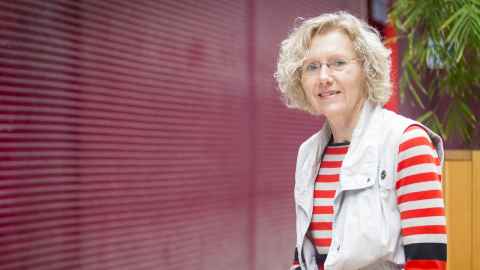When spacetime trembles – forensic statistics and black hole mergers
7 October 2020
Our knowledge of black holes has progressed rapidly in recent decades due to the development of highly sophisticated observatory technology called LIGO or the Laser Interferometer Gravitational-Wave Observatory.

Coupled with a theorem called Bayesian parameter estimation, our knowledge of the universe and its history allowed LIGO to make a breakthrough discovery in 2015: the detection of gravitational waves which are ripples in the fabric of spacetime caused by accelerated massive objects such as black holes. Black holes are formed when massive stars die.
It has been two decades since Bayesian parameter estimation techniques were first introduced for studies in gravitational waves and cosmology and they have helped significantly in pushing at the boundaries of what we know.
Professor Renate Meyer has spent her career using Bayesian techniques to study the universe and in her inaugural lecture she will review the development of statistical methods that enabled the estimation of waveform parameters, such as the masses of the black holes and their distance to earth.
A major focus of current research has been on a more robust nonparametric noise characterisation aiming at a simultaneous estimation of the noise spectral density and gravitational wave parameters. This is now critical for LIGO/Virgo but it might prove to be even more important for the Laser Interferometer Space Antenna (LISA) mission to be launched in 2034.
If robust methods can be developed to handle LISA instrument and galactic confusion noise, LISA will let us go further than any alternative towards the detection of a primordial gravitational wave background, the remnant of the Big Bang.
Renate Meyer is a Professor in the Department of Statistics. After obtaining an MSc and PhD in Mathematics and Statistics from the University of Aachen, Germany, she took up a lectureship at the University of Auckland in 1994.
In 2018, she was awarded a James Cook Research Fellowship by the Royal Society of NZ Te Apārangi for research on noise characterization studies for laser-interferometric gravitational wave observatories and she is co-chair of the NZ Astrostatistics and General Relativity Group of the International LISA Consortium.
Professor Meyer has wide research interests in applied Bayesian inference and MCMC methods. She has been collaborating for many years with astrophysicists on the analysis of gravitational wave data. Her research areas comprise time series analysis with applications in astrophysics, state-space modelling in ecology, multivariate modelling using copulas, survival analysis in medical statistics, and stochastic volatility models for financial time series.
This free public lecture will be held at 6.30pm on Thursday 15 October in Physics Lecture Theatre 1 (303-G20), 23 Symonds Street. Refreshments will be served in the Basement Foyer from 5.45pm.
Media contact
Anne Beston | Media adviser
DDI 09 923 3258
Mob 021 970 089
Email a.beston@auckland.ac.nz